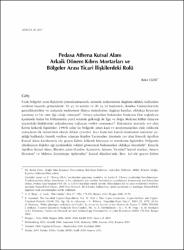Pedasa Athena Kutsal Alanı Arkaik Dönem Kıbrıs Mortarları ve Bölgeler Arası Ticari İlişkilerdeki Rolü
Özet
Archaeological finds obtained from the settlements, sanctuaries, and necropoleis of the southeastern Aegean provide ample and detailed information about the eastern Mediterranean and the cultural and commercial ties established in the archaic period. Among all the imported votive objects, Cypriot votive figurines from the sanctuaries of Samos Heraion, Miletos Aphrodite, Emecik Apollon, and Rhodes constitute, without exception, the largest group in terms of quantity and typological diversity. Finds from the Pedasa Athena sanctuary on the Lelegian Peninsula confirm that the city was in fact a part of the Mediterranean cultural and commercial network. Mortaria, both local and imported, were used as filling material during the construction of the large terrace wall of the Pedasa Athena Sanctuary which dates back to the second half of 4th century B.C. Finds Nos. 1-9 (Figs. 3-4) were among the functional cult objects from the sanctuary and are similar to archaic Cypriot mortaria with their yellow buff appearances, flat bases, diagonal walls, conic bodies, and thick, quadrangular rim profiles. Local imitations repeating the shape (Fig. 5) of imported examples (Cat. nos. 10-12, 14-15), some featuring a decorative band (Cat. no. 13), attest that local examples were soon reproduced in the southeastern Aegean. The majority of the finds (Cat. nos. 1-6, 8-11, 13, 15, 17-18) have been discovered from the same fill as the local and imported high-quality ceramics. Most of the finds from these fills can be dated to the late 7th century B.C. and the first three decades of the 6th century B.C. Mortaria form a close group showing typological and chronological common features as other forms from the same fill. The suggested date of 620-560 B.C. for mortaria unearthed at other centers that show typologically similar features must also be the timeline for the mortaria from Pedasa. The findings from the sanctuaries of Naucratis Apollo, Emecik Apollo, Samos Heraion, Ephesus Artemis, Assesus Athena, and Miletus Aphrodite suggest that mortaria were used to prepare and serve the food and cakes during the rituals for cult purposes in the sanctuaries of the Aegean world and related areas. All the archaeological evidence confirms that mortaria were among the absolutely indispensable cult objects of sanctuaries. Considering the mortaria discovered in southeastern Aegean settlements and sanctuaries, as well as the examples from the commercial cargo of the Çaycağız Koyu shipwreck, they were clearly quite popular in the region for roughly eighty years extending from the third quarter of the 7th century B.C. to the second quarter of the 6th century B.C. The primary cargo of the Kepçe Burnu shipwreck on the shores of Caria dated around the mid-7th century B.C. and the Çaycag?ız Koyu shipwreck dated to the early 6th century B.C. is basket-handled Cypriot amphorae. An overall evaluation of mortaria discovered in settlements, sanctuaries, and shipwrecks in the area reveals that they emerge as commercially valuable merchandise immediately after the mid-7th century when they first appear in the area. The presence of mortaria among the primary merchandise of the cargo aboard the Çaycag?ız Koyu shipwreck leaves no room for doubt about the commercial value of the mortaria. Various functions such as mashing, grinding, and mixing accelerated the rapid spread of imported mortaria and their local counterparts emulating imported originals, and caused them to become widespread in and around the shores of Caria. The scarcity of lekanai and similar bowl forms in the ceramic assemblage from the archaic period of the region explains the ample number of mortaria also used as bowls. Current archaeological data indicates that as of mid-7th century B.C., the relationship between the shores of Caria and Cyprus, which dates far back to the Early Iron Age, continued to grow and evolve in a more regular and uninterrupted fashion. In this network of relations, limestone and terracotta votive objects of Cypriot origin, basket-handled amphorae, mortaria, and surprisingly limited number of other ceramics constitute the documented cluster of data. The collected evidence reveals that the people of Caria were an integral part of the network of cultural and commercial ties in the Mediterranean world and that these relations were instrumental in familiarizing the locals with mortaria. It can be assumed that foreign visitors, locals returning from naval journeys, and mercenaries on their way home contributed towards the popularization of mortaria in the southeastern Aegean. Basket-handled Cypriot amphorae from the shipwrecks indicate that agricultural goods of Carian communities may have held an important place in the relationship between Cypriot and Carian societies as well. For the time being, it may be suggested that the olive oil, wine, and other regional produce of Carian communities played a part in eastern Mediterranean trade. It is striking to see that only a limited number of Cypriot amphorae have been discovered compared to the shipwreck data documented on the shores of the southeastern Aegean. It is evident that merchants of the northeastern Mediterranean procured a portion of the merchandise they sold on the international market directly from Caria and that the amphorae found in the shipwrecks were predominantly used for storing and transporting these goods aboard the ships.
Kaynak
AdalyaCilt
20Sayı
20Bağlantı
https://app.trdizin.gov.tr//makale/TWpnNU1UQXhNUT09https://hdl.handle.net/20.500.12809/8806


















